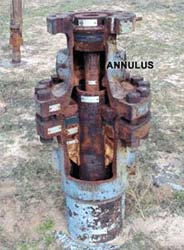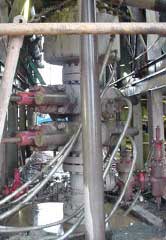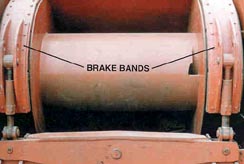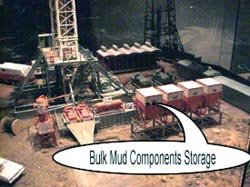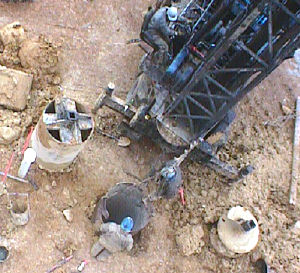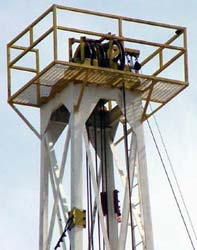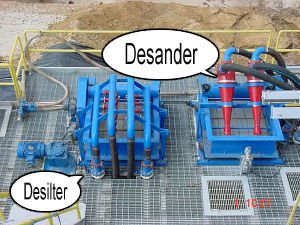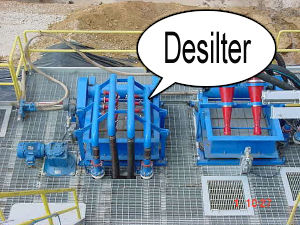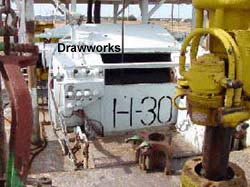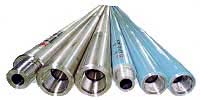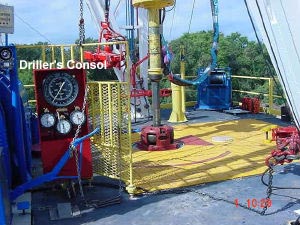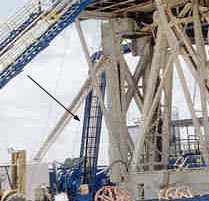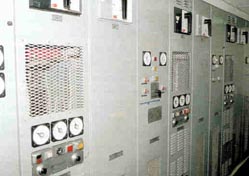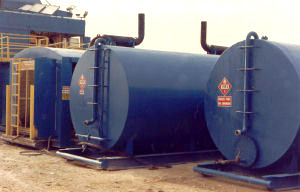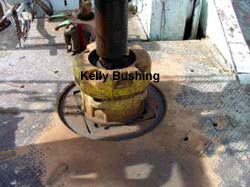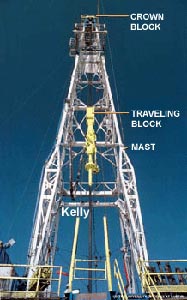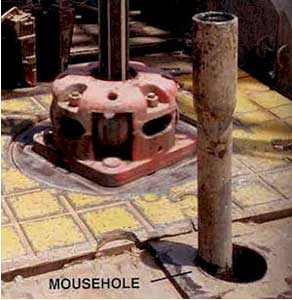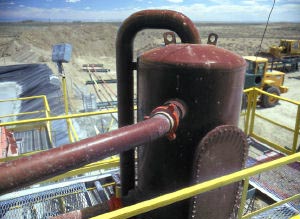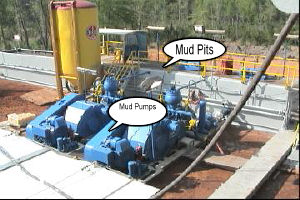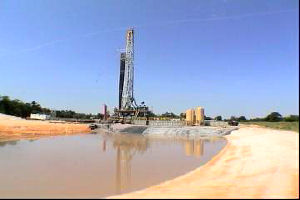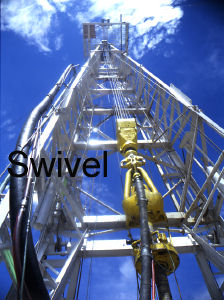Oil and Gas Well Drilling and Servicing eTool
Oil and Gas Well Drilling and Servicing » Glossary of Terms - W
† This is an abridged version of the Dictionary of Petroleum Terms provided by Petex and the University of Texas Austin. © Petex 2001
waiting on cement (WOC)
adj: pertaining to the time when drilling or completion operations are suspended so that the cement in a well can harden sufficiently.

walkways
n: an area cleared for moving through by personnel.
walking beam
n: the horizontal steel member of a beam pumping unit that has rocking or reciprocating motion.
wash over
v: to release pipe that is stuck in the hole by running washover pipe. The washover pipe must have an outside diameter small enough to fit into the borehole but an inside diameter large enough to fit over the outside diameter of the stuck pipe. A rotary shoe, which cuts away the formation, mud, or whatever is sticking the pipe, is made up on the bottom joint of the washover pipe, and the assembly is lowered into the hole. Rotation of the assembly frees the stuck pipe. Several washovers may have to be made if the stuck portion is very long.
washover pipe
n: an accessory used in fishing operations to go over the outside of tubing or drill pipe stuck in the hole because of cuttings, mud, and so forth, that have collected in the annulus. The washover pipe cleans the annular space and permits recovery of the pipe. It is sometimes called washpipe.
washover string
n: the assembly of tools run into the hole during fishing to perform a washover. A typical washover string consists of a washover back-off connector, several joints of washover pipe, and a rotary shoe.
water drive
n: the reservoir drive mechanism in which oil is produced by the expansion of the underlying water and rock, which forces the oil into the wellbore. In general, there are two types of water drive: bottom-water drive, in which the oil is totally underlain by water; and edgewater drive, in which only a portion of the oil is in contact with the water.
water pump
n: on an engine, a device, powered by the engine, that moves coolant (water) through openings in the engine block, through the radiator or heat exchanger, and back into the block.
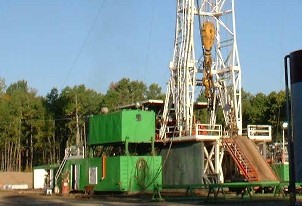
water tank
n: the water tank is used to store water that is used for mud-mixing, cementing, and rig cleaning.
water well
n: a well drilled to obtain a fresh water supply to support drilling and production operations or to obtain a water supply to be used in connection with an enhanced recovery program.
weight indicator
n: an instrument near the driller’s position on a drilling rig that shows both the weight of the drill stem that is hanging from the hook (hook load) and the weight that is placed on the bottom of the hole (weight on bit).
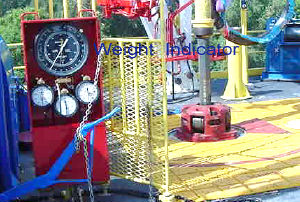
weight indicator
n: a device for measuring the weight of the drill string.
weight on bit (WOB)
n: the amount of downward force placed on the bit.
well
n: the hole made by the drilling bit, which can be open, cased, or both. Also called borehole, hole, or wellbore.
wellbore
n: a borehole; the hole drilled by the bit. A wellbore may have casing in it or it may be open (uncased); or part of it may be cased, and part of it may be open. Also called a borehole or hole.
wellbore soak
n: an acidizing treatment in which the acid is placed in the wellbore and allowed to react by merely soaking. It is a relatively slow process, because very little of the acid actually comes in contact with the formation. Also called wellbore cleanup. Compare acid fracture.
well completion
n: 1. the activities and methods of preparing a well for the production of oil and gas or for other purposes, such as injection; the method by which one or more flow paths for hydrocarbons are established between the reservoir and the surface. 2. the system of tubulars, packers, and other tools installed beneath the wellhead in the production casing; that is, the tool assembly that provides the hydrocarbon flow path or paths.
well control
n: the methods used to control a kick and prevent a well from blowing out. Such techniques include, but are not limited to, keeping the borehole completely filled with drilling mud of the proper weight or density during operations, exercising reasonable care when tripping pipe out of the hole to prevent swabbing, and keeping careful track of the amount of mud put into the hole to replace the volume of pipe removed from the hole during a trip.
well fluid
n: the fluid, usually a combination of gas, oil, water, and suspended sediment, that comes out of a reservoir. Also called well stream.
wellhead
n: the equipment installed at the surface of the wellbore. A wellhead includes such equipment as the casinghead and tubing head. adj: pertaining to the wellhead.
well logging
n: the recording of information about subsurface geologic formations, including records kept by the driller and records of mud and cutting analyses, core analysis, drill stem tests, and electric, acoustic, and radioactivity procedures.
well servicing
n: the maintenance work performed on an oil or gas well to improve or maintain the production from a formation already producing. It usually involves repairs to the pump, rods, gas-lift valves, tubing, packers, and so forth.
well-servicing rig
n: a portable rig, truck-mounted, trailer-mounted, or a carrier rig, consisting of a hoist and engine with a self-erecting mast. See carrier rig. Compare workover rig.
well site
n: see location.
well stimulation
n: any of several operations used to increase the production of a well, such as acidizing or fracturing. See acidize.
wickers
n pl: broken or frayed strands of the steel wire that makes up the outer wrapping of wire rope.
wildcat
n: 1. a well drilled in an area where no oil or gas production exists.
window
n: 1. a slotted opening or a full section removed in the pipe lining (casing) of a well, usually made to permit sidetracking.
wireline
n: a slender, rodlike or threadlike piece of metal usually small in diameter, that is used for lowering special tools (such as logging sondes, perforating guns, and so forth) into the well. Also called slick line.
wireline formation tester
n: a formation fluid sampling device, actually run on conductor line rather than wireline, that also logs flow and shut-in pressure in rock near the borehole. A spring mechanism holds a pad firmly against the sidewall while a piston creates a vacuum in a test chamber. Formation fluids enter the test chamber through a valve in the pad. A recorder logs the rate at which the test chamber is filled. Fluids may also be drawn to fill a sampling chamber. Wireline formation tests may be done any number of times during one trip in the hole, so they are very useful in formation testing.
wireline log
n: any log that is run on wireline.
wireline logging
n: see well logging.
wireline operations
n pl: the lowering of mechanical tools, such as valves and fishing tools, into the well for various purposes. Electric wireline operations, such as electric well logging and perforating, involve the use of conductor line.
wireline survey
n: a general term used to refer to any type of log being run in a well.
wireline tools
n pl: special tools or equipment made to be lowered into and retrieved from the well on a wireline, for example, packers, swabs, gas-lift valves, measuring devices.
wire rope
n: a cable composed of steel wires twisted around a central core of fiber or steel wire to create a rope of great strength and considerable flexibility.
WOB
abbr: weight on bit.
WOC
abbr: waiting on cement; used in drilling reports.
workover
n: the performance of one or more of a variety of remedial operations on a producing well to try to increase production. Examples of workover jobs are deepening, plugging back, pulling and resetting liners, and squeeze cementing. See recompletion.
workover fluid
n: a special drilling mud used to keep a well under control while it is being worked over. A workover fluid is compounded carefully so that it will not cause formation damage.
workover rig
n: a portable rig used for working over a well.
work string
n: 1. in drilling, the string of drill pipe or tubing suspended in a well to which is attached a special tool or device that is used to carry out a certain task, such as squeeze cementing or fishing. 2. in pipeline construction, the string of washpipe that replaces the pilot string in a directionally drilled river crossing. The work string remains in place under the river until the actual pipeline is made up and is ready to be pulled back across the river.



